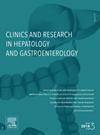肝镜2DTE基于图像的质量指标提高了肝脏硬度测量的适用性和可重复性。
IF 2.6
4区 医学
Q2 GASTROENTEROLOGY & HEPATOLOGY
Clinics and research in hepatology and gastroenterology
Pub Date : 2025-02-01
DOI:10.1016/j.clinre.2025.102532
引用次数: 0
摘要
目的:Hepatoscope®是一种超便携式超声系统,具有50 Hz二维瞬态弹性成像(2DTE),用于肝脏硬度测量(LSM)。它为基于成像特征的单个刚度值提供了质量指数(QI)。本研究评估了慢性肝病(CLD)患者中新手和专家操作人员在各种QI条件下的2DTE用户内部和用户之间的可重复性。我们将其性能与其他成像和非成像弹性成像技术进行了比较。方法:本研究为前瞻性横断面单中心研究。100例CLD患者接受了振动控制瞬态弹性成像(VCTE™)、二维横波弹性成像(2DSWE)和2DTE的lsm。专家和新手分别使用2DTE进行了两次连续测试,对任何输出都不知情。计算了用户内部和用户间重复性的类内相关系数以及各种QI条件的适用性,并评估了Spearman与VCTE和2DSWE的相关性。结果:将LSM计算为10个刚度值的中位数,QI值为85%,在可靠性和适用性之间取得了最佳折衷。在这种情况下,专家和操作者之间的重复性比没有QI阈值(ICC = 分别为0.81和0.79)和95%的适用性有显著改善。新手的可重复性具有更严格的QI (ICC = 0.80)。LSM伴2DTE与VCTE和2DSWE有较强的中度相关性(r分别为0.63和0.55)。结论:2DTE肝镜为CLD患者提供了一种可靠的无创肝硬度评估方法。基于图像的QI的应用提高了LSM在新手和专家操作员之间的可靠性和一致性。本文章由计算机程序翻译,如有差异,请以英文原文为准。
Hepatoscope 2DTE's image-based quality index enhances applicability and repeatability of liver stiffness measurement
Purpose
Hepatoscope® is an ultraportable ultrasound system with 50 Hz two-dimensional transient elastography (2DTE) for liver stiffness measurement (LSM). It provides a quality index (QI) for individual stiffness values that is based on imaging features. This study evaluated the 2DTE intra- and inter-user repeatability in patients with chronic liver diseases (CLD) for novice and expert operators across various QI conditions. We compared the performances with other imaging and non-imaging elastography techniques.
Methods
This investigation was a prospective cross-sectional single-center study. One hundred CLD patients underwent LSMs with vibration-controlled transient elastography (VCTE™), two-dimensional shear wave elastography (2DSWE) and 2DTE. Expert and novice operators each performed two consecutive exams with 2DTE, blinded to any output. Intra-class correlation coefficient for intra-, and inter-user repeatability were calculated as well as applicability for various QI conditions, and Spearman's correlations against VCTE and 2DSWE were assessed.
Results
Computing LSM as the median of 10 stiffness values with a QI>85 % yielded the best compromise between reliability and applicability. In this setting, expert and inter-operator repeatability showed significant improvement over the condition with no QI threshold (ICC = 0.81 and 0.79, respectively) and 95 % applicability. Novice repeatability was excellent with a more restrictive QI (ICC = 0.80). LSM with 2DTE demonstrated strong and moderate correlation with VCTE and 2DSWE (r = 0.63 and 0.55, respectively).
Conclusion
Hepatoscope 2DTE provides a promising and reliable alternative for non-invasive liver stiffness assessment in patients with CLD. The application of the image-based QI enhances LSM reliability and consistency across novice and expert operators.
求助全文
通过发布文献求助,成功后即可免费获取论文全文。
去求助
来源期刊

Clinics and research in hepatology and gastroenterology
GASTROENTEROLOGY & HEPATOLOGY-
CiteScore
4.30
自引率
3.70%
发文量
198
审稿时长
42 days
期刊介绍:
Clinics and Research in Hepatology and Gastroenterology publishes high-quality original research papers in the field of hepatology and gastroenterology. The editors put the accent on rapid communication of new research and clinical developments and so called "hot topic" issues. Following a clear Editorial line, besides original articles and case reports, each issue features editorials, commentaries and reviews. The journal encourages research and discussion between all those involved in the specialty on an international level. All articles are peer reviewed by international experts, the articles in press are online and indexed in the international databases (Current Contents, Pubmed, Scopus, Science Direct).
Clinics and Research in Hepatology and Gastroenterology is a subscription journal (with optional open access), which allows you to publish your research without any cost to you (unless you proactively chose the open access option). Your article will be available to all researchers around the globe whose institution has a subscription to the journal.
 求助内容:
求助内容: 应助结果提醒方式:
应助结果提醒方式:


